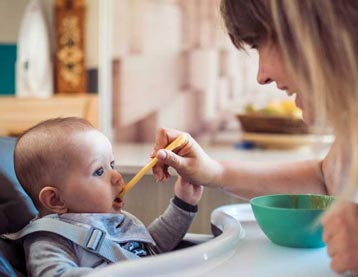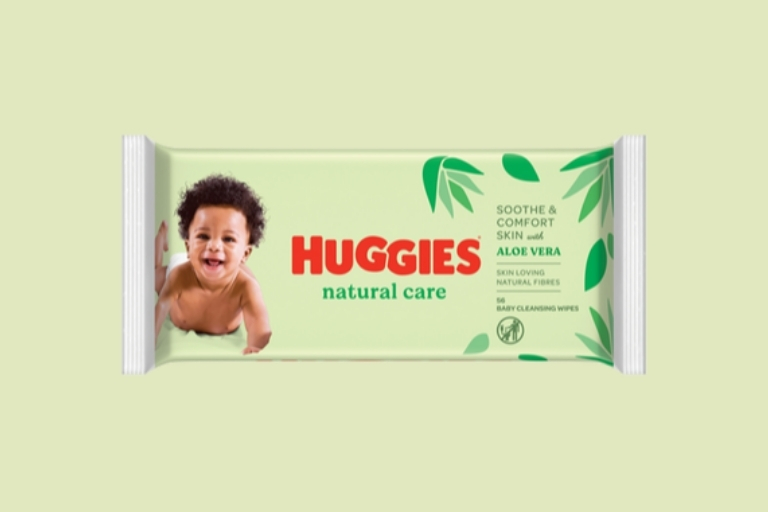How and when to start weaning your baby onto solid foods

One of the most exciting stages of your baby’s development is when they start eating proper food. Parenting editor Sally J Hall advises on when, why and how to start weaning.
When can you start weaning a baby?
Health experts agree you should start weaning your baby at six months.
"Introducing your baby to solid foods, sometimes called complementary feeding or weaning, should start when your baby is around six months old."
- Advice from the NHS
The World Health Organization also suggests six months as the best age to start weaning. This is only a little time before they start learning to crawl, and then begin cruising along furniture.
For the first six months, breast or formula milk gives your baby the nutrition they need. Breastfeeding also gives your child protection against infections, illness and also provides a great opportunity for baby bonding. The NHS now advises that all breastfed babies should be given a daily supplement of vitamin D (8.5 to 10mcg). If your baby is formula-fed and they are having more than 500ml a day, they don’t need a supplement.
Why should I wean my baby at six months?
By this age, your baby has developed well enough to be able to eat and swallow first foods, whether it’s purées or soft food. They can move food around inside their mouth and rather than their tongue sticking forwards, as it does while sucking milk, they can start to use it to push food to the back of the mouth to be swallowed.
Importantly, your baby’s digestive system is developed enough at this age to be able to break down and digest their food.
Though many parents ask, can you start weaning at four months, you should follow health guidelines to wait until that important six-month stage. Babies are more likely to develop an allergy to food as their digestive system is still too immature to cope with food at this age. There is also a greater risk of choking.
It’s also not a great idea to wait longer than six months to start weaning your baby, as the iron stores your baby was born with will be depleted by then and you must top them up with foods rich in iron. Your baby may also miss important milestones such as moving from purées to lumpier textures and may become fussy eaters.
Note: if your baby was premature, seek advice on the best time to start weaning from your Health Visitor.
Signs your baby is ready to start weaning
There are several very strong clues you can look for to be sure that your baby is ready for weaning
- They can sit up well and hold up their head steadily
- They are able to swallow food, rather than spitting it out
- They are able to bring objects to their mouth and coordinate hands, mouth and eyes
Bear in mind that all babies are different, so some develop more quickly than others. Milk should remain the main component of your baby’s diet at this age and it’s all about introducing different flavours and textures.
How to start weaning your baby
Now you can start to introduce the first foods to your baby. Sit your baby up in a highchair, cover clothing with a protective bib and choose some baby plates and bowls to serve their food in.
Ideally, feed your baby when the rest of the family is eating – babies love to mimic and to feel included. If you’re spoon feeding, offer your baby a spoon to hold to encourage self-feeding. At first, they may have only a couple of spoonfuls of food – remember that your baby’s stomach is about the same size as their fist, so it won’t hold a lot!
Offer your baby food when they are alert and happy – not too hungry that they are miserable but not so full from a milk feed that they won’t be interested.
What food and first tastes should you give your baby?
Start with fruit and vegetables, cooked to be soft and either puréed for spoon feeding or cut into fist-sized chunks if you want to try baby-led weaning. Offer baby cereal mixed with some of your baby’s usual milk too (but don’t add it to the bottle as this can increase the risk of your baby choking). Gradually, you can start to add meat, fish or vegan protein (such as tofu) to the menu.
As your baby gets used to the foods you offer, add different flavours. Try one at a time at first, then combine two or three together. Next, you can leave some little lumps in the food or offer crunchier textures so that they get used to this important change.
Eventually, after a year, your baby should be eating more or less the same as you—without the added sugar or salt of course! Keep offering different tastes even if your baby rejects it. It can take several tries before your little one accepts a new flavour.
Foods to avoid when weaning
There are some things you should not give your baby.
Food with added salt or sugar
To start with, you should not add salt or sugar and should avoid processed foods, those containing saturated fats and you should not offer fizzy drinks (especially any with caffeine in them like cola).
Honey
Never offer honey if your child is under one year old. As the NHS explains, honey can occasionally contain ‘bacteria that can produce toxins in a baby's intestines, leading to infant botulism, which is a very serious illness.’
Whole nuts or grapes
Don’t give them whole nuts or grapes, due to the choking risk.
Unpasteurised dairy or raw eggs
Cheese and milk should be pasteurised, while eggs should not be raw and should be Lion marked.
Some oily fish and shellfish
Oily fish such as shark, swordfish, and marlin should be avoided, as they are high in mercury. Babies who are weaning should never have raw or lightly cooked shellfish either.
What can you do about weaning constipation?
You may find that when changing the baby's diet at the beginning of weaning their poo may change. This can lead to them poo less often, however, some babies become constipated as their instensines adapt to handling new foods.
When looking out for baby constipation as a result of weaning be aware of:
- Difficulty or straining when it’s time to poo
- Pain when passing stools
- Pooing less than normal
- Stools are hard or pellet like
- Tummy ache partnered with a poor appetite
What is baby-led weaning?
Baby-led weaning first became popular in 2003, pioneered by author and former midwife Gill Rapley. Baby-led weaning is based around a more relaxed, unstructured approach to weaning, where the baby skips the puree stage. The baby is instead offered solid ‘finger foods’ from the start of weaning, and is encouraged to feed themselves.
These finger foods might include the following:
Vegetables (cooked, soft and cut into the right shape)
Broccoli, butternut squash, carrots, cauliflower, and parsnips are all good finger foods when cut into the right size for little hands, and cooked until they’re soft.
Fruit (soft, or cooked without adding sugar)
Such as apple, pear, peach, melon, banana, or grabbable bits of avocado
Starchy foods, once cooked
Potato, sweet potato, cassava, pasta, noodles, chapatti, and rice can all be cooked and served up to your little one for them to try.
Pulses
Beans and lentils are another type of finger food that is ideal for baby-led weaning.
Fish or meat without bones
Fish, or meat without bones—such as chicken and lamb—are worth including in the finger foods you give your child. Just make sure there are no bones in them, as these are a choking hazard.
Pasteurised full-fat hard cheese or hard boiled eggs
Sticks of pasteurised low salt, full-fat hard cheese such as cheddar are a great way for your baby to try dairy products. Hard boiled eggs are also perfect—plus they’re great to roll around on their plate or high chair!
Should you try baby-led weaning?
Although popular, this method has run into criticism, as some babies may not get the nutrition they need through baby-led weaning.
Some parents can feel anxious about going down a baby-led weaning route, with the choking and allergic reaction risks that it may bring. If you feel like this, but still want to give baby-led weaning a go, you can take a ‘bit of both’ approach. This simply involves encouraging baby-led weaning, but supporting it with occasional pureed food. This way you can make sure your baby is getting what they need from their food, and you’re able to keep a closer eye on possible allergens.
For peace of mind and reassurance, it can also be helpful to attend a first aid course—especially for new parents. Apply for an online course with The Red Cross or download the NHS Baby and Child First Aid app.
Where can I find out more about weaning my baby?
There’s a host of information available about this exciting stage of your baby’s development that it can feel overwhelming. You’ll find more information around food allergies on the NHS website and recipe inspiration on their Start4Life YouTube channel.
For more help with weaning and further nutritional inspiration try Annabel Karmel’s weaning tips, What Mummy Makes on Instagram and Joe Wicks ‘Wean in 15’ cookbook.
Things are about to start moving, fast
If your baby has started weaning, there’s a good chance the next stage isn’t too far away either.
Before you know it, your little one will be crawling, then cruising, then walking! It might be a good time to start baby proofing your home while you can…














